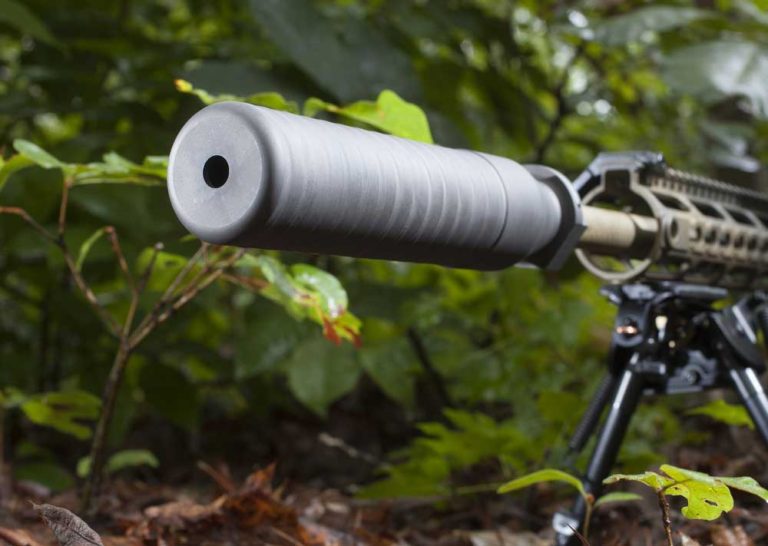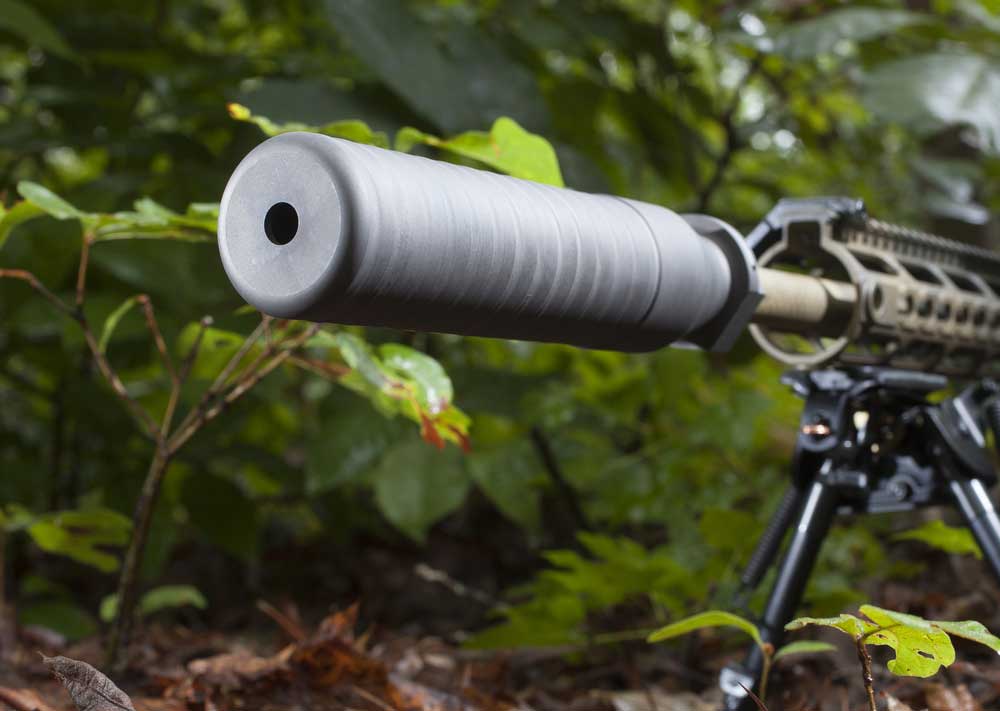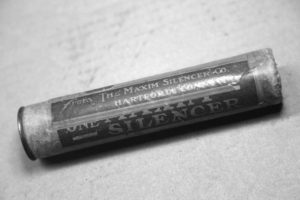

Suppressors have been around for about a century now. Discover how the firearms accessory came about and its early days and uses.
When did silencers come about? Before we can answer that, there’s a couple of things we have to make clear; one, it wasn’t possible to have silencers until the invention of smokeless powder.
Oh, you say “of course” but think about it; the percentage of black powder that is actually combusted is small, compared to that of smokeless. Lots of smoke, lots of powder residue, and lots of cleaning afterwards. But then there is also the matter of noise. Having fired black powder firearms (I was heavily into black powder when I was starting the journey that lead to here) I can attest to the noise being distinctly different, lower-pitched and perhaps at a lower decibel level as well. That is one thing I intend to look into when I have the time and fully wring decibel levels out with the sound meter.
The second thing is the apparent temporal dysfunction of many anti-gunners. From listening to them, you’d think that “assault weapons” came about in the 1980s, that mass shootings didn’t happen until Reagan was elected to the Presidency, and that silencers were unknown before spy movies became popular.
The invention of silencers occurred in the first decade of the 20th century, patented by a fellow named Maxim. No, not the machine-gun Maxim, but his son. Hiram Percy Maxim was not one to go slowly. Even at a time when precocious young men could attend college at an early age, he not only attended MIT early, but graduated early. He patented his first firearms silencer in 1909. We have to be specific, because the Maxim Silent Firearms Company later changed its name and pretty much only made mufflers for internal combustion engines.
Which, when I found out about it, allowed me to connect a few dots. OK, let’s look at the first decade of the 20th century, firearms-wise and other inventions as well. With Roosevelt in office, we’ve now had about a generation of shooters who are familiar with smokeless powder. And it is noisier than black powder. While no one has thought to actually invent hearing protection (at least, not that I’ve been able to find) they had to have noticed that these new cartridges, and smokeless powder, made your ears ring more than grand-dad’s old black powder rifle.
But what was really making everyone cranky were these newfangled horseless carriages. Not to pick on them, but we’ve all been standing on the corner when a Harley goes by, right? Noisy? You betcha. OK, imagine an early automobile, granted not with the horsepower of a Harley, but completely un-muffled. Even your lawnmower has a muffler. Early automobiles got a reputation for scaring horses, disturbing the peace, making a racket, and generally being unpleasant. And deservedly so. Early autos weren’t all that powerful; it took time to get even the most powerful engines up out of the teens as far as horsepower was concerned. But un-muffled, your average city street corner in 1905-1910 sounded like the parking lot of a Harley dealership. As a comparison, a Harley motor can develop on the order of 65-70 horsepower.
Cadillac won the Dewar Trophy in 1914, with a racing car whose engine developed a thundering 40 to 50 horsepower (records vary). Your average automobile in 1914 probably had half that at its disposal. But by 1914, there would have been thousands on city streets. Noisy? Like you can’t imagine, in this era of hybrids and electric cars.
Maxim designed mufflers to tame engine noise. And, since each cylinder combustion was a separate noise event, doing the same to firearms was easy. After all, even an early engine ran at a higher rpm than one of his father’s machine guns, right? If he could tame the noise of a 1,000 rpm engine (when you add in the firing of all the cylinders, and not consider just the rotation of the crankshaft) then a single gunshot was a piece of cake.
I’ve seen early magazine ads for silencers, showing properly dressed gentlemen plinking in their parlors, not even waking up the sleeping dog. If you wanted to buy a silencer back then, you simply sent a check or other funds to the Maxim Company and they mailed you a silencer. (You could probably have simply enclosed cash, since the basic ones were maybe twenty dollars.) Well, they mailed you one if you lived in a rational place. New York City had passed the Sullivan Act in 1911, controlling the purchase of firearms. Meant to keep those unruly southern-European immigrants from getting their hands on guns, I’d be surprised if it didn’t address silencers sooner or later, probably sooner.

I can’t say I’ve had a chance to look at a large number of Maxim suppressors, but I’m not sure anyone alive can say that, with the possible exception of Kevin Brittingham. They were not exactly common when they were new, and time has taken its toll. That, and stupid legislation. But the ones I have seen had some characteristics that jumped out at me. For one, they are all small. I mean, a Maxim silencer meant for use on an ’03 Springfield, in .30-06, is not much bigger than what we now make for a .22LR. He clearly didn’t believe in making them any larger than he had to, or else the end-users were so happy to have something this glorious, it didn’t occur to them to ask, “Can you make it quieter still?”
Second, I have only ever seen a direct-thread mount on a Maxim silencer. I wouldn’t be surprised to find he had done some work to make a quick-connect system of some kind, but the only ones I’ve ever seen were direct-thread. This is solid, simple, easy to understand, and something any competent gunsmith of the time could have managed. Well, a competent gunsmith with a lathe big enough to hold the rifle barrel, perhaps. Now, don’t quote me on that, because as much as I’ve seen, I haven’t seen a lot of Maxim suppressors. Heck, I’m not sure anyone alive has seen a lot of them, they are rare.
Last, his designs were all offset. That is, the bullet path was not down the center of the tube, but traveled along a path above the centerline of the tube. This meant the silencer would not obscure the sights. Interesting, and a reminder that back then, iron sights were the only sights.
Editor's Note: This article is excerpted from Gun Digest Book of Suppressors.

Next Step: Get your FREE Printable Target Pack
Enhance your shooting precision with our 62 MOA Targets, perfect for rifles and handguns. Crafted in collaboration with Storm Tactical for accuracy and versatility.
Subscribe to the Gun Digest email newsletter and get your downloadable target pack sent straight to your inbox. Stay updated with the latest firearms info in the industry.

![Best Concealed Carry Guns In 2025 [Field Tested] Wilson Combat EDC X9S 1](https://gundigest.com/wp-content/uploads/Wilson-Combat-EDC-X9S-1-324x160.jpg)


![Best 9mm Carbine: Affordable PCCs [Tested] Ruger Carbine Shooting](https://gundigest.com/wp-content/uploads/Ruger-Carbine-Shooting-100x70.jpg)
![Best AR-15: Top Options Available Today [Field Tested] Harrington and Richardson PSA XM177E2 feature](https://gundigest.com/wp-content/uploads/Harrington-and-Richardson-PSA-XM177E2-feature-100x70.jpg)

The original units were made for 22 cal rimfires and had interrupted threads for quick attach/disconnect.